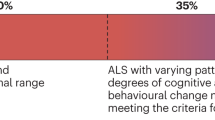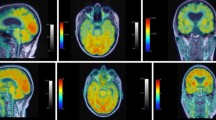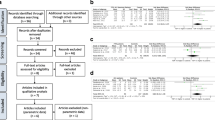Abstract
Frontotemporal dementia (FTD) is the second most frequent dementia, after Alzheimer’s, in patients under the age of 65. It encompasses clinical entities characterized by behavioral, language, and executive control dysfunction. Neurofilament light chain (NfL) is a new, non-disease specific, widely studied biomarker indicative of axonal injury and degeneration. Various studies have previously explored the role of NfL in the diagnostic process, monitoring, and prognosis of dementia. The current systematic review and meta-analysis include all the available data concerning the role of NfL in frontotemporal dementia and its use as a potential biomarker in differentiating patients with FTD from (a) healthy individuals, (b) Alzheimer’s dementia, (c) Dementia with Lewy bodies, (d) Motor Neuron disease, (e) Parkinsonian syndromes, and (f) psychiatric disorders. We also analyze the utility of NfL in distinguishing specific FTD subgroups. Neurofilament light chain has a potential role in differentiating patients with frontotemporal dementia from healthy controls, patients with Alzheimer’s dementia, and psychiatric disorders. Higher NfL levels were also noted in patients with semantic primary progressive aphasia (PPA) when compared with behavioral FTD and non-fluent PPA patients. Further studies exploring the use of NfL in frontotemporal dementia are needed.











Similar content being viewed by others
References
Mackenzie IRA, Rademakers R, Neumann M (2010) TDP-43 and FUS in amyotrophic lateral sclerosis and frontotemporal dementia. Lancet Neurol 9:995–1007
Mackenzie IRA, Neumann M, Baborie A et al (2011) A harmonized classification system for FTLD-TDP pathology. Acta Neuropathol 122:111–113
MacKenzie IRA, Neumann M, Bigio EH et al (2010) Nomenclature and nosology for neuropathologic subtypes of frontotemporal lobar degeneration: an update. Acta Neuropathol 119:1–4
Holm IE, Isaacs AM, MacKenzie IRA (2009) Absence of FUS-immunoreactive pathology in frontotemporal dementia linked to chromosome 3 (FTD-3) caused by mutation in the CHMP2B gene. Acta Neuropathol 118:719–720
Gaetani L, Blennow K, Calabresi P et al (2019) Neurofilament light chain as a biomarker in neurological disorders. J Neurol Neurosurg Psychiatr 90:870–881. https://doi.org/10.1136/jnnp-2018-320106
Khalil M, Teunissen CE, Otto M et al (2018) Neurofilaments as biomarkers in neurological disorders. Nat Rev Neurol 14:577–589. https://doi.org/10.1038/s41582-018-0058-z
Eratne D, Loi SM, Walia N et al (2019) A pilot study of the utility of cerebrospinal fluid neurofilament light chain in differentiating neurodegenerative from psychiatric disorders: a ‘C-reactive protein’ for psychiatrists and neurologists? Aust N Z J Psychiatry. https://doi.org/10.1177/0004867419857811
Liberati A, Altman DG, Tetzlaff J et al (2009) The PRISMA statement for reporting systematic reviews and meta-analyses of studies that evaluate health care interventions: explanation and elaboration. PLoS Med 6:e1000100. https://doi.org/10.1371/journal.pmed.1000100
Hozo SP, Djulbegovic B, Hozo I (2005) Estimating the mean and variance from the median, range, and the size of a sample. BMC Med Res Methodol. https://doi.org/10.1186/1471-2288-5-13
Landqvist Waldö M, Frizell Santillo A, Passant U et al (2013) Cerebrospinal fluid neurofilament light chain protein levels in subtypes of frontotemporal dementia. BMC Neurol. https://doi.org/10.1186/1471-2377-13-54
Abu-Rumeileh S, Mometto N, Bartoletti-Stella A et al (2018) Cerebrospinal fluid biomarkers in patients with frontotemporal dementia spectrum: a single-center study. J Alzheimer’s Dis. https://doi.org/10.3233/JAD-180409
De Jong D, Jansen RWMM, Pijnenburg YAL et al (2007) CSF neurofilament proteins in the differential diagnosis of dementia. J Neurol Neurosurg Psychiatry. https://doi.org/10.1136/jnnp.2006.107326
Pijnenburg YAL, Janssen JC, Schoonenboom NSM et al (2007) CSF neurofilaments in frontotemporal dementia compared with early onset Alzheimer’s disease and controls. Dement Geriatr Cogn Disord 23:225–230. https://doi.org/10.1159/000099473
Falgàs N, Ruiz-Peris M, Pérez-Millan A et al (2020) Contribution of CSF biomarkers to early-onset Alzheimer’s disease and frontotemporal dementia neuroimaging signatures. Hum Brain Mapp. https://doi.org/10.1002/hbm.24925
Ljubenkov PA, Staffaroni AM, Rojas JC et al (2018) Cerebrospinal fluid biomarkers predict frontotemporal dementia trajectory. Ann Clin Transl Neurol. https://doi.org/10.1002/acn3.643
Skillbäck T, Mattsson N, Blennow K, Zetterberg H (2017) Cerebrospinal fluid neurofilament light concentration in motor neuron disease and frontotemporal dementia predicts survival. Amyotroph Lateral Scler Front Degener. https://doi.org/10.1080/21678421.2017.1281962
Skillbäck T, Farahmand B, Bartlett JW et al (2014) CSF neurofilament light differs in neurodegenerative diseases and predicts severity and survival. Neurology. https://doi.org/10.1212/WNL.0000000000001015
Abu-Rumeileh S, Giannini G, Polischi B et al (2019) Revisiting the cerebrospinal fluid biomarker profile in idiopathic normal pressure hydrocephalus: the bologna pro-hydro study. J Alzheimer’s Dis 68:723–733. https://doi.org/10.3233/JAD-181012
Scherling CS, Hall T, Berisha F et al (2014) Cerebrospinal fluid neurofilament concentration reflects disease severity in frontotemporal degeneration. Ann Neurol. https://doi.org/10.1002/ana.24052
Wilke C, Preische O, Deuschle C et al (2016) Neurofilament light chain in FTD is elevated not only in cerebrospinal fluid, but also in serum. J Neurol Neurosurg Psychiatry 87:1270–1272. https://doi.org/10.1136/jnnp-2015-312972
Magdalinou NK, Paterson RW, Schott JM et al (2015) A panel of nine cerebrospinal fluid biomarkers may identify patients with atypical parkinsonian syndromes. J Neurol Neurosurg Psychiatry. https://doi.org/10.1136/jnnp-2014-309562
Hampel H, Toschi N, Baldacci F et al (2018) Alzheimer’s disease biomarker-guided diagnostic workflow using the added value of six combined cerebrospinal fluid candidates: Aβ 1–42, total-tau, phosphorylated-tau, NFL, neurogranin, and YKL-40. Alzheimer’s Dement. https://doi.org/10.1016/j.jalz.2017.11.015
Gaiani A, Martinelli I, Bello L et al (2017) Diagnostic and prognostic biomarkers in amyotrophic lateral sclerosis. JAMA Neurol. https://doi.org/10.1001/jamaneurol.2016.5398
Goossens J, Bjerke M, Van Mossevelde S et al (2018) Diagnostic value of cerebrospinal fluid tau, neurofilament, and progranulin in definite frontotemporal lobar degeneration. Alzheimer’s Res Ther. https://doi.org/10.1186/s13195-018-0364-0
Körtvelyessy P, Heinze HJ, Prudlo J, Bittner D (2018) CSF biomarkers of neurodegeneration in progressive non-fluent aphasia and other forms of frontotemporal dementia: clues for pathomechanisms? Front Neurol. https://doi.org/10.3389/fneur.2018.00504
Paterson RW, Slattery CF, Poole T et al (2018) Cerebrospinal fluid in the differential diagnosis of Alzheimer’s disease: clinical utility of an extended panel of biomarkers in a specialist cognitive clinic. Alzheimer’s Res Ther. https://doi.org/10.1186/s13195-018-0361-3
Meeter LHH, Gendron TF, Sias AC et al (2018) Poly(GP), neurofilament and grey matter deficits in C9orf72 expansion carriers. Ann Clin Transl Neurol 5:583–597. https://doi.org/10.1002/acn3.559
Al Shweiki MR, Steinacker P, Oeckl P et al (2019) Neurofilament light chain as a blood biomarker to differentiate psychiatric disorders from behavioural variant frontotemporal dementia. J Psychiatr Res. https://doi.org/10.1016/j.jpsychires.2019.03.019
Rohrer JD, Woollacott IOC, Dick KM et al (2016) Serum neurofilament light chain protein is a measure of disease intensity in frontotemporal dementia. Neurology 87:1329–1336. https://doi.org/10.1212/WNL.0000000000003154
Matías-Guiu JA, Gómez-Pinedo U, Forero L et al (2019) Plasma neurofilament light chain in primary progressive aphasia and related disorders: clinical significance and metabolic correlates. J Alzheimer’s Dis. https://doi.org/10.3233/JAD-190838
Steinacker P, Anderl-Straub S, Diehl-Schmid J et al (2018) Serum neurofilament light chain in behavioral variant frontotemporal dementia. Neurology. https://doi.org/10.1212/WNL.0000000000006318
van der Ende EL, Meeter LH, Poos JM et al (2019) Serum neurofilament light chain in genetic frontotemporal dementia: a longitudinal, multicentre cohort study. Lancet Neurol. https://doi.org/10.1016/S1474-4422(19)30354-0
Heller C, Foiani MS, Moore K et al (2020) Plasma glial fibrillary acidic protein is raised in progranulin-associated frontotemporal dementia. J Neurol Neurosurg Psychiatry. https://doi.org/10.1136/jnnp-2019-321954
Bacioglu M, Maia LF, Preische O et al (2016) Neurofilament light chain in blood and CSF as marker of disease progression in mouse models and in neurodegenerative diseases. Neuron. https://doi.org/10.1016/j.neuron.2016.05.018
Gong ZY, Lv GP, Gao LN et al (2018) Neurofilament subunit L levels in the cerebrospinal fluid and serum of patients with amyotrophic lateral sclerosis. Neurodegener Dis 18:165–172. https://doi.org/10.1159/000488681
Pujol-Calderón F, Portelius E, Zetterberg H et al (2019) Neurofilament changes in serum and cerebrospinal fluid after acute ischemic stroke. Neurosci Lett. https://doi.org/10.1016/j.neulet.2018.12.042
Pijnenburg YAL, Verwey NA, van der Flier WM et al (2015) Discriminative and prognostic potential of cerebrospinal fluid phosphoTau/tau ratio and neurofilaments for frontotemporal dementia subtypes. Alzheimer’s Dement Diagnosis Assess Dis Monit. https://doi.org/10.1016/j.dadm.2015.11.001
Lista S, Toschi N, Baldacci F et al (2017) Diagnostic accuracy of CSF neurofilament light chain protein in the biomarker-guided classification system for Alzheimer’s disease. Neurochem Int 108:355–360. https://doi.org/10.1016/j.neuint.2017.05.010
Alcolea D, Vilaplana E, Suárez-Calvet M et al (2017) CSF sAPPβ, YKL-40, and neurofilament light in frontotemporal lobar degeneration. Neurology. https://doi.org/10.1212/WNL.0000000000004088
Katisko K, Cajanus A, Jääskeläinen O et al (2020) Serum neurofilament light chain is a discriminative biomarker between frontotemporal lobar degeneration and primary psychiatric disorders. J Neurol. https://doi.org/10.1007/s00415-019-09567-8
Reus LM, Vijverberg EG, Tijms BM et al (2018) Disease trajectories in behavioural variant frontotemporal dementia, primary psychiatric and other neurodegenerative disorders presenting with behavioural change. J Psychiatr Res. https://doi.org/10.1016/j.jpsychires.2018.07.014
Vijverberg EGB, Dols A, Krudop WA et al (2017) Cerebrospinal fluid biomarker examination as a tool to discriminate behavioral variant frontotemporal dementia from primary psychiatric disorders. Alzheimer’s Dement Diagnosis Assess Dis Monit. https://doi.org/10.1016/j.dadm.2017.01.009
Meeter LH, Dopper EG, Jiskoot LC et al (2016) Neurofilament light chain: a biomarker for genetic frontotemporal dementia. Ann Clin Transl Neurol 3:623–636. https://doi.org/10.1002/acn3.325
Abu-Rumeileh S, Capellari S, Stanzani-Maserati M et al (2018) The CSF neurofilament light signature in rapidly progressive neurodegenerative dementias. Alzheimer’s Res Ther. https://doi.org/10.1186/s13195-017-0331-1
Hansson O, Janelidze S, Hall S et al (2017) Blood-based NfL: a biomarker for differential diagnosis of parkinsonian disorder. Neurology 88:930–937. https://doi.org/10.1212/WNL.0000000000003680
Author information
Authors and Affiliations
Contributions
IM: Conceptualization; IM, EK: Methodology; IM, EK: Formal analysis and investigation; EK: Writing—original draft preparation; DK, SC, FP, IM: Writing—review, and editing; IM, DK: Supervision.
Corresponding author
Ethics declarations
Conflict of interest
The corresponding authors state that there is no conflict of interest.
Statement of human and animal rights
This article does not contain any studies with human participants or animals performed by any of the authors.
Informed consent
For this type of study, formal consent is not required.
Additional information
Publisher's Note
Springer Nature remains neutral with regard to jurisdictional claims in published maps and institutional affiliations.
Electronic supplementary material
Below is the link to the electronic supplementary material.
Rights and permissions
About this article
Cite this article
Karantali, E., Kazis, D., Chatzikonstantinou, S. et al. The role of neurofilament light chain in frontotemporal dementia: a meta-analysis. Aging Clin Exp Res 33, 869–881 (2021). https://doi.org/10.1007/s40520-020-01554-8
Received:
Accepted:
Published:
Issue Date:
DOI: https://doi.org/10.1007/s40520-020-01554-8




